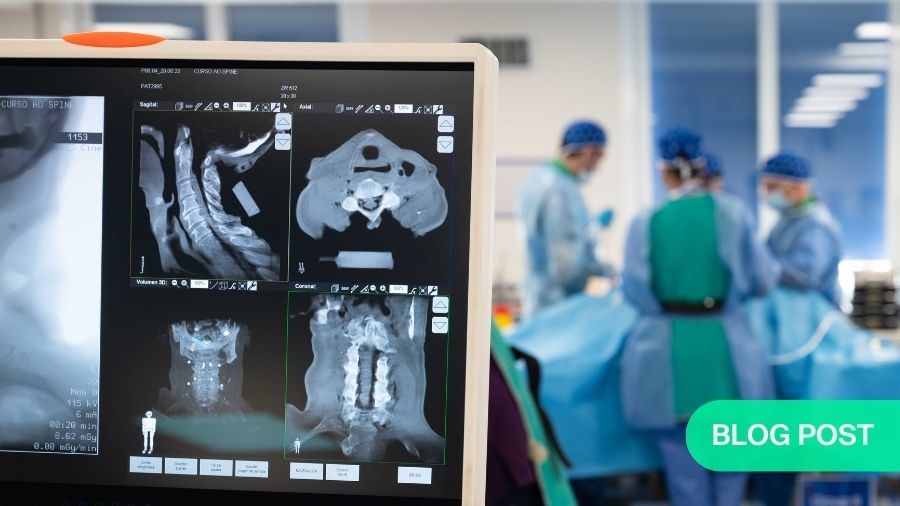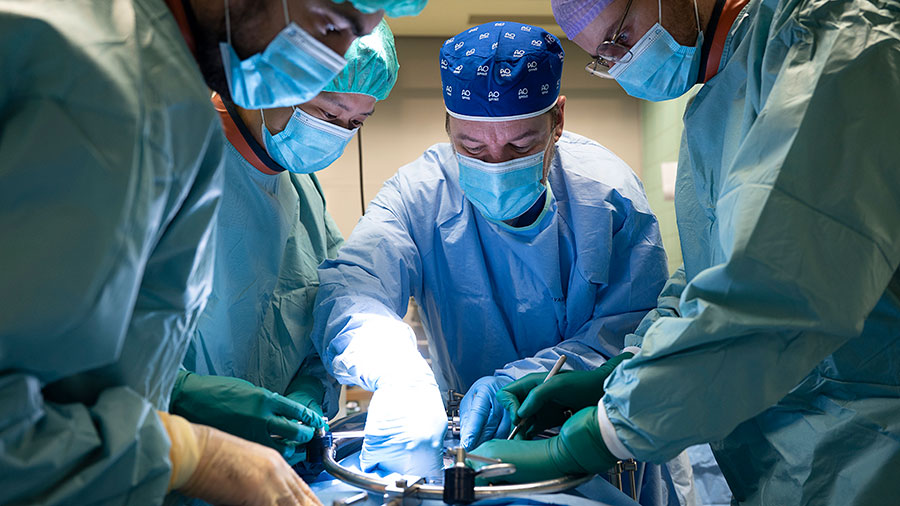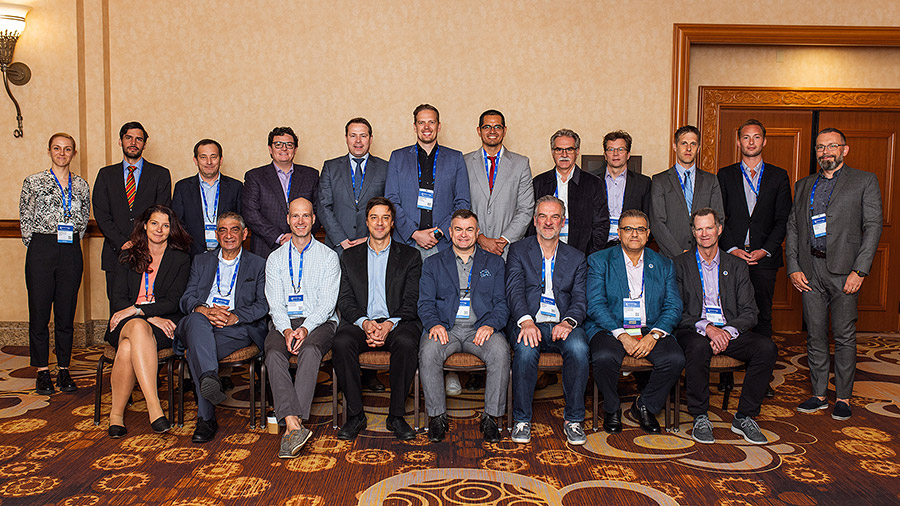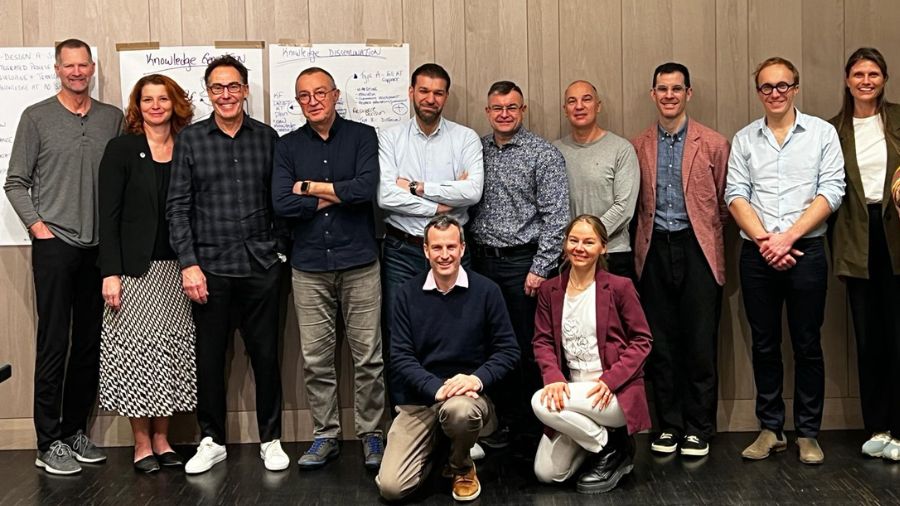Evolving minimally invasive techniques in posterior cervical spine instrumentation
BY DR PHILIPP SCHLEICHER

Posterior cervical spine surgery often presents significant challenges, with soft tissue problems being some of the most frequent and devastating complications. Wound dehiscence, infections, and junctional kyphosis are among the most common complications that can result from traditional open procedures (1). These complications are not only distressing for the patient but also increase the overall cost and recovery time for the procedure. In fact, the posterior cervical/cervico-thoracic approach, in particular, exhibits infection rates as high as 18% (2–4), a troubling statistic for spine surgeons. Every spine surgeon has encountered posterior cervical surgery cases with horrifying soft tissue issues.
-
Read the quick summary:
- Dr Philipp Schleicher discusses posterior cervical surgery and how minimally invasive techniques are responding to the specific challenges of the approach.
- Minimally invasive techniques reduce soft tissue complications: The transition from open surgery to percutaneous techniques, especially in thoraco-lumbar spine surgery, has reduced soft tissue damage, blood loss, pain, and infection rates, highlighting the potential for similar benefits in the posterior cervical spine.
- Challenges in applying percutaneous methods to the cervical spine: The cervical spine’s small pedicles and proximity to critical structures (e.g., spinal cord, vertebral artery) require highly precise techniques. The use of advanced imaging and robotic navigation systems is necessary for successful implementation.
- Ideal conditions for percutaneous techniques: The cervical spine's segmental mobility in trauma cases or ankylosing conditions presents an opportunity for percutaneous stabilization. These conditions enable more precise navigation and avoid complications arising from the need for extensive decompression.
- Article is published for the AO Spine Knowledge Forum Trauma & Infection.
Disclaimer: The article represents the opinion of individual authors exclusively and not necessarily the opinion of AO or its clinical specialties.
The development of percutaneous techniques in the thoraco-lumbar spine has been one of the major innovations in spinal surgery during the past decades, with significantly decreased soft tissue damage (5), leading to reduced blood loss, pain and massively reduced infection rates (6) so that these techniques have become indispensable nowadays.
In view of the above-average infection rates of the posterior cervical spine approach and the significantly reduced infection problems with percutaneous approaches in the thoracic/spinal region, the use of percutaneous techniques on the dorsal cervical spine would be extremely obvious.
With the advent of cannulated screws, minimally invasive techniques in the posterior cervical spine have been used for transarticular fixation of the C1-C2-joint complex as early as the mid 1990’s (7). Subaxial treatment was limited to non-instrumented keyhole-decompression due to the lack of specifically designed percutaneous stabilization systems (8–11).
The transfer of percutaneous techniques from the thoraco-lumbar spine to the cervical spine is not trivial, though: The small dimensions of cervical pedicles and the proximity of the spinal cord and vertebral artery requires an order of magnitude greater precision in screw placement. Radiographic landmarks visible on 2D-fluoroscopy are lacking (12) .
As a consequence, a high-resolution 3D-intraoperative imaging system in combination with a navigation or robotic system is a conditio-sine-qua-non for the percutaneous application of internal fixation at the subaxial cervical spine.
With the broader distribution of these technologies, medtech companies obviously consider the market situation for the development of percutaneous implant systems to be promising: In the past few years, more than one percutaneous system has achieved market maturity and is available; the majority of competitors have these systems in their pipeline (13) .
Difficulties to be overcome include the high segmental mobility of the cervical spine, which affects precision of navigation much more than in the thoracic spine.
The second difficulty to overcome is the development of strategies to include effective decompression techniques into the minimally invasive concept as a whole.
In spine trauma, the problem of segmental mobility has to be regarded in a unique way:
Undoubtedly, mobility in the acutely injured spine segment is gross and exceeds any physiologic level – which in most cases is also the basis for the surgical indication.
But: Posterior instrumentation in spine trauma is often used as supporting posterior tension band after reduction, decompression and anterior stabilization of a complete facet dislocation (F4) or additive stabilization after corpectomy / plating of a complete burst (A4) fracture.
A further frequent indication for posterior instrumentation includes stabilization of an injured ankylosing spine—where segmental mobility beside the injured segment is near to zero.
In my opinion, these two applications represent the ideal indication for implementation of percutaneous stabilization in the cervical spine, because of limited segmental mobility (facilitating navigation without registration of every single vertebra) and no need for extensive decompression, which both interfere with the available percutaneous techniques.
The advancing development of percutaneous posterior instrumentation in the cervical spine seems definitely to be considered as the next powerful innovation in the field of spine surgery, which we from the AO Spine KFTI regard as major milestone to be observed closely: Solving the soft tissue issues in the posterior cervical spine will be of great benefit to our patients and will help to reduce a lot of suffering from complicated courses.
About the author:
Dr Philipp Schleicher began his career at the Department of Trauma Surgery at the Charité Berlin under the direction of Professor Norbert P. Haas. His interest in spinal surgery was awakened very early on when he began his doctoral thesis under the supervision of Frank Kandziora.
In 2008, he moved to the BG Unfallklinik in Frankfurt am Main with Frank Kandziora, Klaus Schnake, and Matti Scholz, where he supported the establishment of the interdisciplinary Department of Spinal Surgery and Neurosurgery and currently holds the position of Senior Consultant.
His special interests are injuries of the cervical spine and biomechanical issues. Among other things, he played a leading role in the development of the German guideline for injuries of the subaxial cervical spine. Schleicher is an associate member of AO Spine Knowledge Forum Trauma and Infection.
References and further reading:
- Barbanti-Brodano G, Griffoni C, Halme J, Tedesco G, Terzi S, Bandiera S, et al. Spinal surgery complications: an unsolved problem—Is the World Health Organization Safety Surgical Checklist an useful tool to reduce them? Eur Spine J. 2020;29(5):927–36.
- Kwon BK, Fisher CG, Boyd MC, Cobb J, Jebson H, Noonan V, et al. A prospective randomized controlled trial of anterior compared with posterior stabilization for unilateral facet injuries of the cervical spine. J Neurosurg: Spine. 2007 Jul;7(1):1–12.
- Mehta AI, Babu R, Sharma R, Karikari IO, Grunch BH, Owens TR, et al. Thickness of Subcutaneous Fat as a Risk Factor for Infection in Cervical Spine Fusion Surgery. J Bone Jt Surg. 2013;95(4):323–8.
- Lu K, Tu Y, Su S, Ding J, Hou X, Dong C, et al. Machine learning application for prediction of surgical site infection after posterior cervical surgery. Int Wound J. 2024;21(4):e14607.
- Chung AS, Ballatori A, Ortega B, Min E, Formanek B, Liu J, et al. Is Less Really More? Economic Evaluation of Minimally Invasive Surgery. Glob Spine J. 2021;11(1_suppl):30S-36S.
- Phan K, Rao PJ, Mobbs RJ. Percutaneous versus open pedicle screw fixation for treatment of thoracolumbar fractures: Systematic review and meta-analysis of comparative studies. Clin Neurol Neurosurg. 2015;135:85–92.
- McGuire RA, Harkey HL. Unstable Jefferson’s fracture treated with transarticular screws. Orthopedics [Internet]. 1995 Feb;18(2):207 209.
- Eicker SO, Steiger HJ, El-Kathib M. A Transtubular Microsurgical Approach to Treat Lateral Cervical Disc Herniation. World Neurosurg. 2016;88:503–9.
- Celestre PC, Pazmiño PR, Mikhael MM, Wolf CF, Feldman LA, Lauryssen C, et al. Minimally Invasive Approaches to the Cervical Spine. Orthop Clin N Am. 2012;43(1):137–47.
- Fessler RG, Khoo LT. Minimally invasive cervical microendoscopic foraminotomy: an initial clinical experience. Neurosurgery. 2002;51(5 Suppl):S37-45.
- Hussain I, Schmidt FA, Kirnaz S, Wipplinger C, Schwartz TH, Härtl R. MIS approaches in the cervical spine. J Spine Surg. 2019;5(S1):S74–S74.
- Schaefer C, Begemann P, Fuhrhop I, Schroeder M, Viezens L, Wiesner L, et al. Percutaneous instrumentation of the cervical and cervico-thoracic spine using pedicle screws: preliminary clinical results and analysis of accuracy. Eur Spine J. 2011;20(6):977–85.
- Coric D, Rossi V. Percutaneous Posterior Cervical Pedicle Instrumentation (C1 to C7) With Navigation Guidance: Early Series of 27 Cases. Glob Spine J. 2022;12(2_suppl):27S-33S.
You might also be interested in:
Minimally Invasive Spine Surgery (MISS)
AO Spine MISS educational material and courses cover all types of minimally invasive spine operations through tubular/microscopic, endoscopic, and instrumented procedures.
AO Spine Knowledge Forum Trauma and Infection
Systematically bringing the world on the same page to improve the care of all patients with spinal column injury.
Knowledge Translation (KT)
AO's Knowledge Translation initiative, supported by AO innovation funding, aims to accelerate the uptake of research findings and new knowledge.
AO Spine Guest Blog
AO Spine shares and disseminates topical guest articles from the global spine community, showcasing experiences, knowledge, and expertise from our community.






